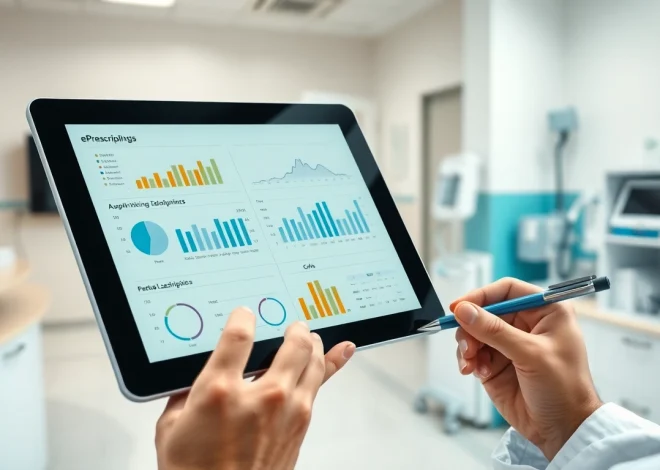
Top Apps for Electronic Prescriptions: Streamlining Healthcare Efficiency
Understanding Electronic Prescriptions
What Are Electronic Prescriptions?
Electronic prescriptions, or e-prescriptions, represent a digital way of generating and transmitting prescriptions from a provider to a pharmacy. This process eliminates the inaccuracies associated with handwritten prescriptions and enhances the overall efficiency of the healthcare delivery system. With e-prescribing, providers can easily send prescriptions directly to pharmacies, ensuring that medication is accurately filled, tracked, and managed throughout the patient’s treatment journey.
Benefits of Using Apps for Electronic Prescriptions
The transition from traditional paper prescriptions to apps for electronic prescriptions offers wide-ranging benefits for healthcare providers and patients alike. Here are some key advantages:
- Improved Accuracy: E-prescriptions are less prone to errors related to handwriting. This reduces the chances of miscommunication between healthcare providers and pharmacies.
- Time Efficiency: Providers can instantly send prescriptions without needing to contact the pharmacy by phone, thus saving valuable time during appointments.
- Medication Management: Apps for electronic prescriptions allow providers to access patients’ medication histories easily, improving drug safety and decreasing the risk of harmful drug interactions.
- Enhanced Patient Adherence: E-prescriptions can help improve patients’ adherence to medication regimens by sending reminders and alerts through connected applications.
Regulatory Aspects of Electronic Prescriptions
Regulatory compliance is paramount when using e-prescribing systems. Guidelines such as the Drug Enforcement Administration (DEA) regulations for controlled substances dictate the use of secure systems that ensure confidentiality and integrity in prescription transmissions. In many jurisdictions, both providers and pharmacies must verify identities through multi-factor authentication, employing a balance of security and accessibility.
Key Features to Look for in Apps for Electronic Prescriptions
User-Friendly Interface
An intuitive and user-friendly interface is critical for ensuring that healthcare providers can navigate the e-prescribing application with ease. A straightforward design aids quick adoption among inexperienced users and reduces the time spent on training.
Integration with EHR Systems
Integrating e-prescribing apps with Electronic Health Record (EHR) systems is essential for streamlined workflows. Facilities that utilize EHR systems will benefit from automatic updates to patient records, medication lists, and allergies—all critical information when prescribing new medications.
Security and Compliance Measures
Security remains a vital consideration when selecting an e-prescribing application. Features such as end-to-end encryption, secure logins, and regular software updates to meet HIPAA compliance are essential in protecting patient data and maintaining trust.
Top Apps for Electronic Prescriptions to Consider
Popular Mobile Solutions
Numerous applications exist that cater to healthcare professionals looking to streamline their prescribing processes. Each app may come with unique features tailored to the specific needs of providers. Continue reading as we explore some standout options:
Comparative Analysis of Features
While selecting an e-prescribing app, it’s essential to conduct a comparative analysis. Essential features to evaluate include:
- Ease of Use: Assess how quickly a new prescriber can learn to use the app effectively.
- Prescription Management Tools: Determine whether the app allows for managing refills and tracking prescription history.
- Support and Training: Evaluate the availability of customer support and training resources to assist both providers and pharmacy staff.
User Feedback and Ratings
User feedback plays a crucial role in evaluating the effectiveness of various e-prescribing apps. Ratings from healthcare professionals can provide insight into daily usability and overall satisfaction:
- Consider looking for ratings on platforms to gauge how long-term users view the utility of specific applications.
- Reading reviews on updates and how frequently bugs are addressed can also inform your choice of e-prescribing app.
Addressing Common Challenges with Electronic Prescriptions
Navigating Technical Issues
Technical issues can arise with any software application. Healthcare providers need to recognize common challenges and implement strategies to overcome them quickly. Regular system checks, accessible tech support, and ongoing training for staff can create an environment better equipped to handle technical difficulties.
Ensuring Provider Adoption
The transition to e-prescribing requires a current buy-in from all practice staff, which can be a significant hurdle. To encourage widespread adoption, consider the following strategies:
- Conducting training sessions: Engage all relevant personnel through workshops that focus on the benefits and functionalities of the e-prescribing app.
- Seeking feedback: Playing an active role in soliciting input from users can help management understand the app’s enhancements their colleagues would find helpful.
Patient Education and Engagement
Educating patients about electronic prescriptions is an often-overlooked aspect of the transition. Providing clear communication about how e-prescriptions work, how patients can access their medications, and the benefits of using such technologies will improve patient compliance and satisfaction.
Future Trends in Electronic Prescriptions
Advancements in Technology
As technology advances, the future of e-prescriptions looks bright. Innovations in artificial intelligence and machine learning are contributing to smarter prescribing practices by analyzing patient data for more personalized treatment options. Additionally, the integration of telehealth services continues to grow, allowing patients to receive prescriptions in a virtual setting.
Impact on Patient Outcomes
Research indicates a correlation between the use of e-prescribing applications and improved patient outcomes. Electronic prescribing minimizes medication errors and enhances patient engagement, thereby increasing the likelihood of improved health results. As more healthcare practitioners adopt such technologies, these positive trends are likely to continue flourishing.
Regulatory Changes on the Horizon
Ongoing discussions within regulatory bodies suggest that more changes may come to how e-prescribing is managed in the future. Stakeholders need to stay informed about impending legislation and guidelines that could affect their practices.


